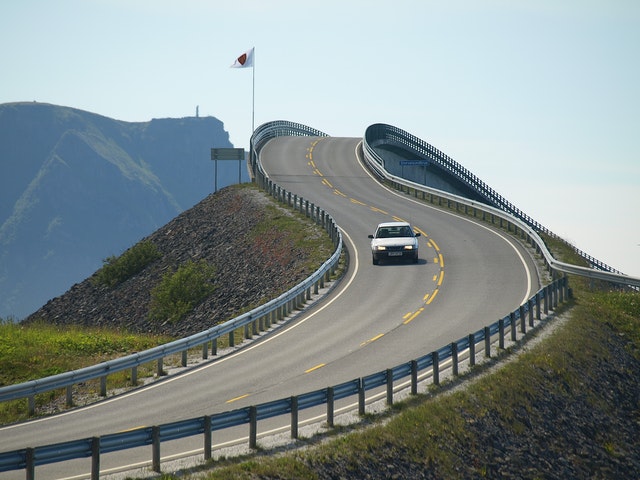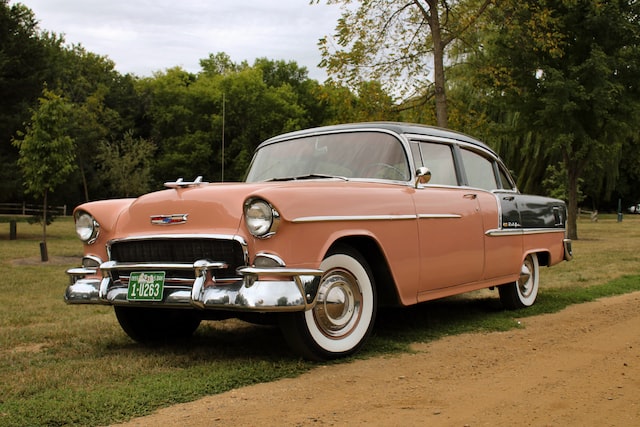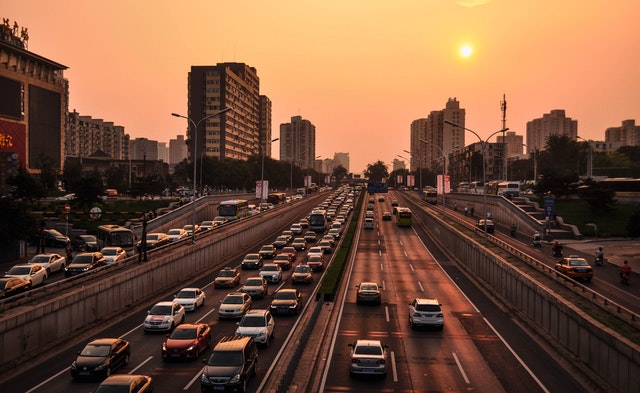Many serious traffic accidents on the highway still happen on a regular basis, but the fault is largely due to the highway driver not having the necessary skills to circulate and handle dangerous situations. Therefore, “How to drive on the highway?” is always considered a topic of interest for many people, especially inexperienced drivers even when they still get their official driving license. Follow these survival tips for driving on the highway to help you stay safe.
How To Drive On The Highway?

- Choose the proper lane
Many inexperienced drivers often wonder which lane to choose on the highway. This will depend on the vehicle type, speed, and level of the driver. Each lane will have its own advantages and disadvantages. If a highway has 4 lanes (no vehicle type specified), normally the 2 left lanes close to the center of the road will be the same-speed lane, the middle lane has a lower speed, and the innermost lane will be the same speed lane. Features of highway lanes:
Centered lane
With this lane, cars can run at the highest speed in the lanes, with good visibility, just need to stay on one side of the road. According to highway driving experience, this is the easiest lane to run if you have certain driving skills. However, this lane also has the disadvantage that it is easy to ask for overtaking if the car is not running at high speed.
Same-speed lane in the middle
This lane has the advantage of being able to run at the highest speed in the lanes, good observation. The downside is that it has to be aligned on both sides. This is quite difficult for new and inexperienced drivers. If the steering wheel is out of control, it will be very dangerous to deviate from the lane.
Low-speed lane
This lane has the advantage of being able to run slower, easy to align, just need to align to one side. The disadvantage is that they often have to pass large trucks and container trucks. Because these vehicles are heavy and carry heavy loads, the traffic speed is slower, so most of them will run in this lane.
- Run at the indicated speed
On highways, there are always speed signs and signposts. Depending on the actual situation, each highway and section of road will have different instructions. Through these signs, the driver will know how many lanes the road has, how to divide it, what the speed limit for each lane is…
Particularly for speed regulations, there will be maximum speed and minimum speed. The maximum speed sign on the highway is a white sign with a red border and black text. The minimum speed sign is a blue sign with white letters. The maximum speed of the highway is not more than 120 km/h. The minimum highway speed is usually around 50-60 km/h.
When driving on the highway, the driver needs to follow the signposts, especially the speed sign to run at the prescribed speed in his lane. You not only need to pay attention to the maximum speed but also need to know the minimum speed to maintain a suitable speed to ensure safety. Remember that if you run too slowly, it is very dangerous for yourself as well as other people.
- Keep a safe distance from other vehicles
An important highway driving technique is to always keep a safe distance. Because this will give the driver enough time to handle unexpected situations from the front, avoiding collisions, especially continuous collisions.
On highways, there are often signs specifying the minimum distance between two vehicles. When encountering this sign, maintain a distance equal to or greater than the value indicated on the sign. In normal dry road conditions, the general safe distance is:
- Vehicles traveling at a speed of 60 km/h: Minimum safe distance of 35m
- Vehicles traveling at speeds from 60 to less than 80 km/h: Minimum safe distance of 55m
- Vehicles traveling at speeds from 80 to less than 100 km/h: Minimum safe distance of 70m
- Vehicles traveling at speeds from 100 to less than 120 km/h: Minimum safe distance of 100m
NOTE: In special cases where the vehicle speed is below 60 km/h, the driver also needs to actively adjust the appropriate distance. This distance will depend on the density of vehicles and the actual traffic situation.
- Do not suddenly change lanes on highways
Vehicles driving on highways reward driving at very high speeds (60km/h, 80km/h, 120km/h,…). Therefore, if you suddenly change lanes, it is likely that the vehicle behind will not keep up with your speed. Your sudden lane change will accidentally surprise the driver behind, causing them to lose control of the wheel, leading to serious consequences.
You should note that you are only allowed to change lanes at places where signs allow or areas with lane markings that allow changing lanes. When changing lanes, turn on the turn signal to signal to drivers ahead and behind you to clearly understand your intentions and to help prevent you from making the mistake of changing lanes without a signal. After that, continue to observe the speed of the vehicle ahead and the vehicle behind to keep a certain safe distance before changing lanes.
When changing lanes, you need to check the speed in the lane you are about to enter to adjust to reduce/accelerate accordingly before entering the lane to ensure that the vehicles behind you can easily coordinate in case of need.
-
Concentrate while driving on the highway
Driving on long trips is torture for anyone because it will cause you back pain, fatigue, even lack of sleep leading to loss of alertness. Therefore, when driving on the highway, you need to avoid habits that affect driving concentration such as using mobile phones, adjusting the overhead rearview mirror, finding lost items, adjusting the air conditioner, turning the knob… Because anything that distracts you from driving can lead to a serious accident.
- Optimize vehicle visibility
Vehicles on highways will connect in a more orderly manner when traveling in residential areas. Therefore, the safest way to drive on the highway is that you need to adjust the rearview mirror outside the car so that when turning left/right, the body only occupies about 1/5 of the inside of the mirror. And when sitting upright, almost no details on the body appear in the mirror.
This adjustment helps all blind spots appear in the outside rearview mirror. The habit of keeping your car’s body in front of the outside rearview mirror is basically not doing you any good on the highway. Therefore, expand your view through the front windshield. At the same time, pay attention to what is happening in front of the vehicle in front. Because those things are also within your sight and you have nothing to lose by being mindful of that.
- Locate stops and comply with regulations
When driving on the highway, there will often be stops for the driver to rest or the vehicles have problems along the way and are looking for help. If you intend to move your vehicle into these stops, you need to determine its position in advance, then turn on your turn signal and gradually move into the most suitable lane closest to the stop.
When an emergency stop is required, the vehicle should be removed from the roadway. If you can’t do that, you have to find a way to signal to other drivers. Many drivers violate the safety rule that just leaving a stop is pressing the accelerator and entering the traffic lane without paying attention to the rear, leading to a sudden collision.
- Do not encroach on the emergency lane
Many drivers, when they see a traffic jam, immediately move to the emergency lane, but do not know the use of this lane. Attention, the emergency lane is only used in cases such as your car is damaged, has a problem, needs help waiting. Emergency lanes are often distinguished from other lanes by having a solid white line.
If you want to get more information about DMV Test, visit our website and try free DMV practice test, or download it for your IOS or Android devices now!
How To Enter The Highway?
Entering the improper highway lane can lead to a very high risk of an accident. So be very careful. Below is the method to enter the highway safely:
- Step 1: Observe
The driver needs to observe all directions around from left to right, from front to back through the rearview mirrors in the car, even have to turn around if necessary. However, pay attention to turning quickly when there is no vehicle ahead to avoid hitting the rear of the vehicle in front.
- Step 2: Turn on the turn signal
After observing the directions and finding that the space is safe enough to change lanes, it is necessary to turn on your signal lights early to notify other vehicles of your vehicle’s upcoming intentions. You can even honk your horn to signal to other vehicles that your vehicle needs to change lanes.
It should be noted that you are the one who joins the traffic, so you do not have the right to have priority on the road. Other drivers don’t want to get out of your lane, so they’ll stay at the same speed and it’s all up to you to adjust your speed and safely merge into the lane.
- Step 3: Accelerate at the same speed as the other vehicle
In the sections entering the highway, a lane is usually arranged for speeding vehicles to prepare to enter the highway. When entering this lane, pay attention to watching for vehicles behind on the highway. If you see a continuous stream of vehicles in the lane you want to enter, wait patiently. Because when going from the branch road you will not be given priority. Other vehicles have the right to yield or not to yield. So pay close attention to look for gaps.
- Step 4: Find a safe space and enter the lane
When you find a space, accelerate and merge with the vehicle at the same speed as the other vehicles. When entering highway lanes, it is necessary to note that when entering the highway, it is necessary to remember to enter the lane definitely without lurking, do not enter the lane suddenly, lack of observation, and do not have warning lights. In addition, it is advisable to limit stopping in the acceleration lane to enter the lane. If the car is too crowded, can’t find a space, move at a safe speed to wait.
The technique of passing another vehicle

Before passing another vehicle, you need to carefully observe the vehicles passing by. Remember that you are only allowed to pass if you are eligible. Before passing, you need to turn on the turn signal to attract the vehicle ahead. There are two types of overtaking on highways: passing vehicles in the same lane and passing vehicles in other lanes.
- Passing vehicles in other lanes
According to highway driving experience, if you pass a vehicle in a different lane, you should drive to a position so that your car enters the rearview mirror of the vehicle in front. Then honk your horn and flash your headlights to signal to the driver ahead. If you see them turn on their signal in their lane, there could be a problem ahead or they’re signaling they’re about to change lanes. At this point, slow down to monitor the situation.
If you request to pass but do not see any signal from the vehicle in front, please step on the accelerator so that the nose of your car runs horizontally with the car in front for about 2 seconds to observe the situation. If the road is clear and there is no problem, continue to step on the accelerator hard to pass decisively.
- Passing vehicles in the same lane
When passing vehicles in the same lane, it is also necessary to signal with a horn (flashing headlights) combined with turn signals. If they see the vehicle in front turn on the turn signal, it means they want to notify them that there is a problem ahead or they will change to another lane to give way. At this point, slow down to monitor the situation.
If the signal for overtaking is signaled, but the vehicle in front has no signal, change to the next lane. After changing lanes, apply the technique of passing vehicles in other lanes as above. When running in the next lane, accelerate until you can create a safe distance, then enter the previous lane.
Principles of emergency stopping lanes on highways
The emergency stop lane on the highway is the rightmost lane. Emergency stop lanes are usually narrower than other lanes and are separated by solid lines. The emergency stop lane on the highway is effective for vehicles in trouble to pull over and park to wait for an ambulance, to avoid affecting the traffic of other vehicles.
When the vehicle encounters an emergency situation and wants to stop in the emergency lane, the driver needs to turn on the hazard warning lights. Next, observe the vehicles moving behind, sequentially change lanes until you enter the emergency stop lane. Never change lanes in a row.
When you have stopped in the emergency lane, still turn on the warning light to warn other vehicles, especially when driving at night. Turn the steering wheel to the right so that in case another car hits, your car will rush out instead of rushing back onto the highway. Finally, pull the handbrake. Then contact the nearest rescue unit. On highways, there are often signs with phone numbers for rescue services. You can also look up the highway’s emergency service phone number online.
In case the vehicle is not in an emergency, absolutely do not arbitrarily stop in the emergency lane, do not run into the emergency lane, do not overtake other vehicles in the emergency lane, etc.
What To Prepare Before Driving On The Highway?
Before each trip on the highway, you should carefully check the safety of the tires, specifically check the tire pressure. If the tire is too soft, it will make your car consume lots of fuel and easily tilt when running fast. If the pump is too hard, when running at a fast speed, the friction between the roughness of the road surface and the tire causes the air to expand, which will easily lead to exploding. A standard tire will usually be inflated to between 2.2 and 2.4 kg.
Many serious traffic accidents are caused by worn or expired car tires that the driver has not yet replaced, resulting in high-speed traffic, the tires are loaded and the close contact with the road surface causes a tire to explode at high speed and lead to serious consequences. There are also cases due to the carelessness of the mechanic when changing the tire in the wrong direction of the tire spokes with the guide wheel with some required tires or over-inflating the tire pressure.
That is why when traveling on highways, drivers need to pay attention to regularly checking tires and standard pressure parameters. In addition, do not overload, and when the vehicle shows signs of tire wear, quickly change the tire before continuing your journey.
In general, handling situations on the highway is a difficult challenge and requires the driver’s practical experience. We hope that this article about how to drive on the highway will partly help you gain more skills to ensure the safety of yourself and other road users.

UT Utah License Renewal: A 2024 Comprehensive Guide
Discover the ultimate guide to Utah license renewal! This comprehensive guide delves into the intricacies of renewing your driver's license in Utah,...
February 13, 2023

South Carolina S.C. Driver's License Renewal
The South Carolina S.C. driver's license renewal process is designed to be comprehensive, taking into consideration eligibility requirements, renewal methods,...
February 13, 2023

Pennsylvania PA DMV License Renewal: A 2024 Full Guide
The Pennsylvania PA DMV license renewal process is designed to be comprehensive, taking into consideration eligibility requirements, renewal methods,...
February 10, 2023

